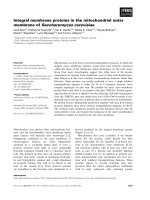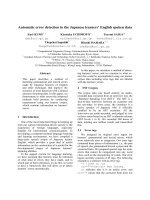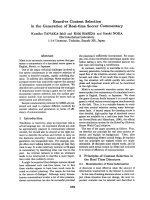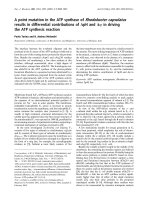Báo cáo khoa học: "A Key advances in critical care in the out-of-hospital setting: the evolving role of laypersons and technology" docx
Bạn đang xem bản rút gọn của tài liệu. Xem và tải ngay bản đầy đủ của tài liệu tại đây (37.03 KB, 3 trang )
Page 1 of 3
(page number not for citation purposes)
AED = automated external defibrillator; CPR = cardiopulmonary resuscitation; ICU = intensive care unit.
Available online />Abstract
During the past decade, critical care in the out-of-hospital setting has
transcended the original emphasis on on-scene advanced life
support interventions by doctors, paramedics, and nurses. Many of
the life-saving efforts and advances in critical care situations have
now begun to focus more and more on how, through evolving
technology, the average person can save lives and perhaps even
spare precious intensive care unit (ICU) resources. A striking example
was the recent study conducted at the Chicago airports at which
automated external defibrillators (AEDs) were deployed throughout
the airline terminals for use by the public at large. Not only did random
bystanders on the concourses save an extremely high percentage of
cardiac arrest patients with the AEDs, most patients rapidly
awakened, even before the arrival of professional rescuers. Thus, this
technology-assisted intervention, performed by an average person,
pre-empted the need for many other critical care interventions and
prolonged care in the ICU. Equipped with automated prompts to
improve performance, new technology also exists to help to monitor
the inadequacies and too-frequent interruption of life-saving chest
compressions during basic cardiopulmonary resuscitation. As a result
of these technological advances, survival rates for cardiac arrest are
now expected to improve significantly.
As we first developed intensive care units (ICUs) for our
hospitals in the 1960s, we also developed our first mobile
ICUs [1,2]. For some of us, our critical care practice has
focused more and more on the out-of-hospital setting, and
emergency medical services systems have now become our
ICUs [1-3]. During the past decade, the out-of-hospital
mobile ICU transcended the advanced life support practiced
on-scene by paramedics, nurses, doctors, and other
prehospital care providers [4,5]. As explained in the following
discussion, many of the life-saving efforts and advances for
critical care situations have now begun to focus increasingly
on how the average person can save lives, and perhaps even
spare precious ICU resources.
Many prehospital care providers have espoused the concept
that ‘a gram of good prehospital care can save a kilogram of
in-hospital ICU care’. In the case of automated external
defibrillators (AEDs), it seems that the 1,500 grams
constituting the typical weight of an AED may indeed save
much more than that. In fact, the technological evolution of
AEDs has now also changed our traditional notions of a
‘critical care practitioner’. Today’s AEDs are so easy to use
that even schoolchildren can operate them easily with little or
no previous instruction [6]. Today, AEDs have become a
standard part of basic cardiopulmonary resuscitation (CPR)
training for the average person, and public access to
defibrillation has become an encouraged practice, at least
within certain guidelines [7-9].
The most striking testimony to the success of AEDs was the
recent study conducted at the Chicago airports where AEDs
were deployed throughout the airport terminals for use by the
public at large [9]. It had been previously established that
AEDs could be used successfully by specially targeted,
specially trained ‘laypersons’ such as flight attendants and
casino security guards [7,8]. However, this particular study
was conducted specifically to determine whether the
average, random bystander in the airport, with no duty to act,
would retrieve the device, use it successfully, and, of course,
save lives [9].
The results of this novel critical care investigation in a public
setting were profound. In the first 2 years of operation,
survival rates for persons collapsing with cardiac arrest in the
airport concourses exceeded 75% and most of the patients
were already awakening before the arrival of traditional
emergency medical services units [9]. In contrast to the
traditional experience with most out-of-hospital cardiac arrest
Commentary
Key advances in critical care in the out-of-hospital setting:
the evolving role of laypersons and technology
Paul E Pepe
1,2,3
and Jane G Wigginton
1,3
1
The University of Texas Southwestern Medical Center and the Parkland Health and Hospital System, 5323 Harry Hines Boulevard, Dallas,
TX 75390-8579, USA
2
City of Dallas Medical Emergency Services for Public Safety, Public Health and Homeland Security, 5323 Harry Hines Boulevard, Dallas,
TX 75390-8579, USA
3
Dallas Metropolitan BioTel (EMS) System, 5323 Harry Hines Boulevard, Dallas, TX 75390-8579, USA
Corresponding author: Paul E Pepe,
Published: 9 February 2006 Critical Care 2006, 10:119 (doi:10.1186/cc4838)
This article is online at />© 2006 BioMed Central Ltd
Page 2 of 3
(page number not for citation purposes)
Critical Care Vol 10 No 1 Pepe and Wigginton
survivors, who typically remained in coma for significant
periods [10,11], these rapidly wakening patients clearly did
not experience the usual need for endotracheal intubation,
mechanical ventilation, therapeutic hypothermia, and various
intravenous pharmacological infusions [10,11]. Therefore, with
the rapid use of AEDs by random bystanders, the usual
scenario of aggressive ICU care, invasive assessments and a
myriad of consultations was pre-empted for a large
percentage of those patients who, traditionally, would have
required them.
Even more impressive was the fact that many of the persons
who had operated the AEDs for these survivors had never
been trained how to use them [9]. In essence, technology
has now made the average person readily capable of
delivering life-saving critical care. Considering that sudden
cardiac death due to ventricular fibrillation is one of the
greatest causes of premature mortality in many societies, the
magnitude of the public health impact of AEDs is potentially
dramatic, in terms of both life-saving and ICU resources. In
summary, the use of AEDs by the average person may be
considered one of the greatest advances in critical care
medicine during the past decade.
Similarly, recent technology has also enhanced the quality of
basic CPR. For the past four decades, basic CPR has been
performed by both laypersons and health professionals with
significant life-saving effects [12]. However, its infrequent
performance has been cited as perhaps the weakest link in the
worldwide chain of survival and a key reason for low survival
rates worldwide [12]. More recently, the quality of basic CPR
techniques has come center-stage in resuscitation research
efforts [8]. In addition to evaluating the concept of markedly
abbreviating the time taken to provide effective training for the
masses [13], recent investigations using sophisticated (but
easy to apply) monitoring devices suggest that current CPR
performance may also be inadequate in most circumstances
[14,15]. However, using similar monitoring devices, the
rescuers can now be prompted, during an actual CPR event,
to make modifications in their techniques, and, in turn,
significantly improve outcomes [8,14,15].
Specifically, there has been a renewed focus on the depth,
rate, and recoil phase of chest compressions and an even
stronger emphasis on not interrupting chest compressions to
maintain coronary perfusion [8,14-18]. Furthermore, to avoid
frequent interruptions of chest compressions, there has been
a strong move to limit the rate of rescue breathing, especially
in the first few minutes after sudden, unexpected collapse
when oxygenation and ventilation support is of limited value
[8,17,18]. In addition, the evidence has been growing
steadily for deferring initial defibrillation attempts until a brief
period of aggressive chest compressions can first be
performed when the circulatory arrest was not witnessed by
responding professional rescuers and several minutes have
likely elapsed [8,19]. Evidence also strongly indicates that, in
defibrillation attempts, the ‘hands-off’ intervals between
interruption of chest compressions and the delivery of the
countershock should be limited to only a few seconds [8,20].
In all of these areas of concern, evolving technology will
eventually prompt the appropriate actions.
These concepts and advances in basic AED and CPR
techniques have now become the cornerstone for the
recently published international guidelines for CPR [8]. As a
result of such guidelines and through the help of ever-
evolving technology, the average person may very well
become an even more effective ‘critical care practitioner’ over
the next decade.
Competing interests
The author(s) declare that they have no competing interests.
References
1. Baskett TF, Baskett PJ: Frank Pantridge and mobile coronary
care. Resuscitation 2001, 48:99-104.
2. Cobb LA, Alvarez H, Copass MK: A rapid response system for
out-of-hospital cardiac emergencies. Med Clin North Am
1976, 60:283-290.
3. Pepe PE, Mattox KL, Duke JH, Fisher PB, Prentice FD: Effect of
full-time specialized physician supervision on the success of
a large, urban emergency medical services system. Crit Care
Med 1993, 21:1279-1286.
4. Pepe PE: ACLS systems and training programs – do they
make a difference? Respir Care 1995, 30:427-433.
5. Copass MK, Oreskovich MR, Bladergroen MR, Carrico CJ: Pre-
hospital cardiopulmonary resuscitation of the critically injured
patient. Am J Surg 1984, 148:20-26.
6. Gundry JW, Comess KA, DeRook FA, Jorgenson D, Bardy GH:
Comparison of naïve sixth-grade children with trained profes-
sionals in the use of an automated external defibrillator. Cir-
culation 1999, 100:1703-1707.
7. The Public Access Defibrillation Trial Investigators: Public-access
defibrillation and survival from out-of-hospital cardiac arrest.
N Engl J Med 2004, 351:637-646.
8. American Heart Association: The 2005 American Heart Associ-
ation guidelines for cardiopulmonary resuscitation and emer-
gency cardiovascular care. Part 4. Adult basic life support.
Circulation 2005, 112:19-34.
9. Caffrey SL, Willoughby PJ, Pepe PE, Becker LB: Public use of
automated external defibrillators. N Engl J Med 2002, 347:
1242-1247.
10. Hypothermia After Cardiac Arrest Study Group: Mild therapeutic
hypothermia to improve the neurological outcome after
cardiac arrest. N Engl J Med 2002, 346:549-546.
11. Longstreth WT Jr, Diehr P, Inui TS: Prediction of awakening
after out-of-hospital cardiac arrest. N Engl J Med 1983, 308:
1378-1382.
12. Cummins RO, Ornato JP, Thies WH, Pepe PE: Improving sur-
vival from sudden cardiac arrest: the ‘chain of survival’
concept. Circulation 1991, 83:1832-1847.
13. Roppolo LP, Ohman K, Pepe PE, Idris AH: The effectiveness of
a short cardiopulmonary resuscitation course for laypersons.
Circulation 112(Suppl II):325-326.
14. Wik L, Kramer-Johansen J, Myklebust H, Sorebo H, Svensson L,
Fellows B, Steen PA: Quality of cardiopulmonary resuscitation
during out-of-hospital cardiac arrest. JAMA 2005, 293:299-304.
15. Abella BS, Alvarado JP, Myklebust H, Edelson DP, Barry A,
O'Hearn N, Vanden Hoek TL, Becker LB: Quality of cardiopul-
monary resuscitation after in-hospital cardiac arrest. JAMA
2005, 293:305-310.
16. Aufderheide TP, Pirrallo RG, Yannopoulos D, Klein JP, von
Briesen C, Sparks CW, Deja KA, Conrad CJ, Kitshca DJ, Provo
TA, Lurie KG: Incomplete chest wall compressions: a clinical
evaluation of CPR performance by EMS personnel and
assessment of alternate manual chest compression-decom-
pression techniques. Resuscitation 2005, 64:353-362.
Page 3 of 3
(page number not for citation purposes)
17. Berg RA, Sanders AB, Kern KB, Hilwig RW, Heidenreich JW,
Porter ME, Ewy GA: Adverse hemodynamic effects of inter-
rupting chest compressions for rescue breathing during car-
diopulmonary resuscitation for ventricular fibrillation cardiac
arrest. Circulation 2001, 104:2465-2470.
18. Roppolo LP, Pepe PE, Cimon N, Gay M, Patterson B, Yancey A,
Clawson JJ: Modified cardiopulmonary resuscitation (CPR)
instruction protocols for emergency medical dispatchers;
rationale and recommendations. Resuscitation 2005, 65:203-
210.
19. Pepe PE, Fowler R, Roppolo L, Wigginton J: Re-appraising the
concept of immediate defibrillatory attempts for out-of-hospi-
tal ventricular fibrillation. Crit Care 2004, 8:41-45.
20. Koster RW: Limiting ‘hands-off’ periods during resuscitation.
Resuscitation 2003, 58:275-276.
Available online />









